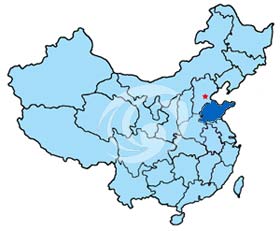 Shandong, the home of Tsingtao Beer, Haier Electronics and Confucius, is located in the lower reaches of the Yellow River and bordered by the Bohai and Yellow Seas. Shandong faces Japan and the Korean Peninsula to the east, and lies next to Hebei province in the northwest and Henan Province in the south. Situated between the Yellow River Economic Belt and the Bohai Ring Economic Area, its location is geographically strategic both within the mainland and in the East Asian and Asian economic regions. Shandong is the 19th largest province in the country. Central Shandong is mountainous, with hills that undulate to the east and south.
Shandong, the home of Tsingtao Beer, Haier Electronics and Confucius, is located in the lower reaches of the Yellow River and bordered by the Bohai and Yellow Seas. Shandong faces Japan and the Korean Peninsula to the east, and lies next to Hebei province in the northwest and Henan Province in the south. Situated between the Yellow River Economic Belt and the Bohai Ring Economic Area, its location is geographically strategic both within the mainland and in the East Asian and Asian economic regions. Shandong is the 19th largest province in the country. Central Shandong is mountainous, with hills that undulate to the east and south.
Climate
Shandong is located in the warm temperate zone with a semi-tropical monsoon climate. The annual average temperature is 11°C to 14°C and annual average precipitation is 550-950 mm. The frost-free period in the coastal area is more than 180 days, and more than 220 days in the inland areas.
People
Shandong Province was formally established in the Qing Dynasty (1644 - 1911), with its capital at Jinan. Today, the province has been administratively divided into 139 counties, cities and districts. More than 91.25 million people live in the province, the second most populous in China after Henan.
History and culture
Shandong is known as the "Home of Confucius and Mencius," "Home of Calligraphy," and "Home of folklore Culture."
Over 2,000 years ago, during the Spring and Autumn and Warring States periods, Confucius, the founder of the Confucian School, and Mencius, his successor, were born in the Lu Kingdom located in the southern part of modern Shandong Province. The hometown of Confucius and Mencius is respectively Qufu and Zoucheng. Today, these places still boast rich cultural relics buried underground, as well as abundant cultural sites above ground. Among those of extremely important historical and cultural value, are the Confucius Temple, the Confucius Mansion and the Confucius Forest, and the Mencius Temple, Mencius Mansion and Mencius Forest. Spacious rooms, grand halls, deep ancient courtyards, and various tombs and tablets have become popular attractions for Chinese and foreign tourists.
 Shandong Province is known as the home of Chinese calligraphy. Hidden in the temples and mountains of the province are innumerable ancient tablets and stone inscriptions, making it a treasure house of Chinese calligraphy. Many of these can be found on Mount Taishan. There is a scenic spot called "Jingshiyu", where one can find an amazing tablet, 1,000 square meters in size. The inscription is devoted to a famous Buddhist scripture entitled "Diamond Sutra." More magnificent is a cliff carving on top of Mount Taishan, which carries an Inscription written by Li Longji, an emperor of the Tang Dynasty. The imposing inscription serves as a reminder of the romantic love story of the Emperor and Yang Yuhuan, his highest-ranking imperial concubine.
Shandong Province is known as the home of Chinese calligraphy. Hidden in the temples and mountains of the province are innumerable ancient tablets and stone inscriptions, making it a treasure house of Chinese calligraphy. Many of these can be found on Mount Taishan. There is a scenic spot called "Jingshiyu", where one can find an amazing tablet, 1,000 square meters in size. The inscription is devoted to a famous Buddhist scripture entitled "Diamond Sutra." More magnificent is a cliff carving on top of Mount Taishan, which carries an Inscription written by Li Longji, an emperor of the Tang Dynasty. The imposing inscription serves as a reminder of the romantic love story of the Emperor and Yang Yuhuan, his highest-ranking imperial concubine.
In the Dai Temple at the foot of the mountain, there is a stone inscription by Qin ' ershi" (the second emperor of the Qin Dynasty). It bears the calligraphy seal of Li Si, a famous prime minister of the Qin Dynasty who was in power over 2,000 years ago. Though there are only ten characters left, the tablet is incredibly valuable. Famous tablets in Shandong also include include some from the Wei Dynasty, which are found on Tianzhu Mountain in Pingdu and the Yunfeng Mountain in Laizhou, which are considered masterpieces of Chinese calligraphy.
Visitors to Shandong will find the area's folklore to be of interest. The sea worshipping ceremony of the coastal areas in the Jiaodong Peninsula and the Jiao zhou yangko (a popular rural folk dance) features the unique folklore of the local fishermen; the kites of Weifang, the wood-block New Year Pictures of Yangjiabu, the paper cutting of Gaomi, and the colored glaze of Boshan are representatives of the farmer's culture. The folk handicrafts and customs of western Shandong are deeply rooted in the tradition of the Confucian culture.
Shandong province is the site of three of China's most famous mountains, Mount Taishan, Mount Laoshan and Mount Mengshan. Rising from the North China Plain, Mount Taishan ranks first among the "Five Sacred Mountains" of China. "As stable as Mount Taishan" is a famous Chinese idiom extolling the extraordinary grandeur of the mountain. Its name signifies peace. Many emperors, high-ranking officials of the imperial courts and men of letters of ancient times ascended the mountain. They left behind rich cultural legacies from the foot to the top, making the mountain a shrine of Chinese cultural history.
Mount Laoshan faces the coast of the Yellow Sea, and looks totally different from Mount Taishan. During the Song and Yuan Dynasties, Taoist temples were built on Mount Laoshan, making it a famous Taoist sacred place.
Scenic Mount Mengshan, lying in the south of Shandong, is known for its majesty, deep valleys, waterfalls and springs. It is said that there are 72 peaks and 36 caves in the mountain, of which the 1156-meter-high Guimeng Peak is the second highest in the province.

